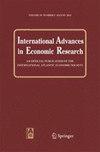COVID-19危机期间的数字消费者行为和电子商务趋势
IF 0.7
Q3 ECONOMICS
引用次数: 45
摘要
新冠肺炎全球大流行迅速改变了电子商务。2019年,欧洲以3519亿美元的收入成为第三大电子商务市场。预计到2025年,年增长率(6.0%)将使欧洲的收入达到5659亿美元。总体而言,由于COVID-19危机,2020年欧洲的电子商务收入增长了10% (Statista, https://www.statista.com/study/42335 /ecommerce-report/2021, 2021)。新的电子商务标准建立在传统营销理论的基础上(Haan et al., Journal of marketing, 2018;Sunder et al., Journal of Marketing Research, 2016;Verhoef, Journal of Marketing, 2017)通过对数字消费者行为特征的理解,发展消费者洞察力和创造价值主张,为消费者提供更高水平的满意度(Achrol和Kotler, Journal of Marketing Science, 2012;Eggert et al.,工业营销管理,2020;Payne and Frow, Journal of Services Marketing, 2020)。在2019冠状病毒病危机期间,消费者行为和购买习惯发生了根本性变化。本文探讨了COVID-19危机对数字消费者行为的影响,并讨论了影响捷克共和国在线购物和电子商务最新趋势的因素。潜在的调查对象是分两波从不同的世代中挑选出来的。基于世代队列理论(Igelhart,普林斯顿大学出版社,1997),目前的研究将受访者群体定义为:Alpha世代(2011-至今),Z世代(1997 - 2010),Y世代(千禧一代)(1983-1996),X世代(1965-1982),婴儿潮一代(1946-1964),Int Adv Econ Res https://doi.org/10.1007/s11294-021-09817-4本文章由计算机程序翻译,如有差异,请以英文原文为准。
Digital Consumer Behaviour and eCommerce Trends during the COVID-19 Crisis
The COVID-19 global pandemic has rapidly changed e-commerce. With revenues of US $351.9 billion, Europe was the third largest e-commerce market in 2019. Annual growth (6.0%) is projected to lead to revenues of US $565.9 billion by 2025 in Europe. Overall, e-commerce revenues saw 10% additional growth in Europe in 2020 due to the COVID-19 crisis (Statista, https://www.statista.com/study/42335 /ecommerce-report/2021, 2021). New e-commerce standards build on traditional marketing theories (Haan et al., Journal of Marketing, 2018; Sunder et al., Journal of Marketing Research, 2016; Verhoef, Journal of Marketing, 2017) with the added insight of understanding digital consumer behavioural characteristics, developing consumer insights and creating value propositions that offer consumers higher levels of satisfaction (Achrol and Kotler, Journal of the Academy of Marketing Science, 2012; Eggert et al., Industrial Marketing Management, 2020; Payne and Frow, Journal of Services Marketing, 2020). During the COVID-19 crisis, consumer behaviour and purchasing habits fundamentally changed. This paper examines the effect the COVID-19 crisis had on digital consumer behaviour and discusses factors affecting online shopping and the latest trends in ecommerce in the Czech Republic. Potential respondents were selected from different generational cohorts in two waves. Based on generation cohort theory (Igelhart, Princeton University Press, 1997), the current research defined respondent cohorts as follows: Generation Alpha (2011-present), Generation Z (1997–2010), Generation Y (Millennials) (1983–1996), Generation X (1965–1982), Baby Boomers (1946–1964), Int Adv Econ Res https://doi.org/10.1007/s11294-021-09817-4
求助全文
通过发布文献求助,成功后即可免费获取论文全文。
去求助
来源期刊

International Advances in Economic Research
ECONOMICS-
CiteScore
1.50
自引率
8.30%
发文量
19
期刊介绍:
International Advances in Economic Research (IAER) was established to promote the dissemination of economic and financial research within the international community. Founded in 1995 by the International Atlantic Economic Society, a need was identified to provide the latest research on today''s economic policies and tomorrow''s economic and financial conditions. Economists can no longer be concerned with professional developments only in their home country. Research by scholars in one country can easily have implications for other countries, yet often vital results are not shared. Economic restructuring in a shrinking world demands close analysis and careful interpretation. In IAER, authors from around the globe look at these issues, coming together in the cross-fertilization of multinational ideas. The journal provides economists, financial specialists, and scholars in related disciplines with much-needed opportunities to share their insights with worldwide colleagues. Policy-oriented, empirical, and theoretical research papers in all economic and financial areas are welcome, without regard to methodological preferences or school of thought. All manuscripts are submitted to a double-blind, peer review process.
In addition to formal publication of full-length articles, IAER provides an opportunity for less formal communication through its Research Notes section. A small point may not be worthy of a full-length, formal paper but is important enough to warrant dissemination to other researchers. Research in progress may be of interest to other scholars in the field. A research approach ending in negative results needs to be shared to save others similar pitfalls. Research Notes has been established to facilitate this form of communication. The section provides a means by which short manuscripts of less than 200 words can quickly appear in IAER. The review process for these shorter manu scripts is usually completed within 30 days.
Officially cited as: Int Adv Econ Res
 求助内容:
求助内容: 应助结果提醒方式:
应助结果提醒方式:


